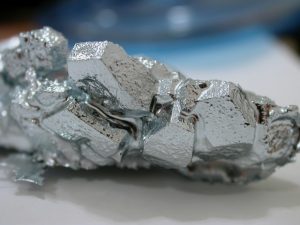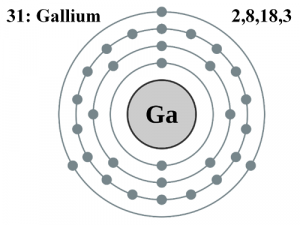Gallium
What is Gallium?
Gallium is a transition metal in group 13 and period 4 of the periodic table (Fig 1). It has a silvery blue appearance (Fig 2). It is solid but soft at standard temperature and pressure, and has a low melting temperature of 29.76 °C. Gallium has applications in electronics, solar energy, astronomy, and medical technology.
Gallium’s Place in the Periodic Table
![]() Gallium was discovered by Paul-Émile Lecoq de Boisbaudran; he named Gallium after his country of citizenship. Galia is the name for France in Latin. Gallium is a post-transition metal, located in group 13 and period 4 of the periodic table. Post-transition metals are brittle and do not conduct electricity as well as transition metals. Aluminum and indium are also in group 13.
Gallium was discovered by Paul-Émile Lecoq de Boisbaudran; he named Gallium after his country of citizenship. Galia is the name for France in Latin. Gallium is a post-transition metal, located in group 13 and period 4 of the periodic table. Post-transition metals are brittle and do not conduct electricity as well as transition metals. Aluminum and indium are also in group 13.
- Atomic number: 31
- Atomic Radius: 135 picometers
- Atomic mass: 69.723
- Symbol: Ga
- Group: 13
- Period: 4
- Number of Protons: 31
- Number of Electrons: 31
- Number of Neutrons: 68 (60% abundance), 71 (40% abundance)
- Number of Isotopes: 31 (only 2 naturally occurring)
Properties of Gallium
Gallium is a shiny, silvery blue metal with an appearance similar to Aluminum. Gallium is solid at room temperature and conducts heat and electricity poorly. It melts just above room temperature at 29.76°C. Only three other metals are liquid at room temperature (Cs, Fr, and Hg). Gallium does not exist as a pure metal on Earth but is found in small amounts associated with ores of aluminum and zinc. Metallic gallium is non-toxic.

Physical Properties
Gallium is very brittle. It is easily shattered into pieces when cold. At room temperature, it is so soft, that you could cut through it with a butter knife. Your body temperature is 37°C. Pure gallium would melt in your hand. Once it melts on your hand, it would be hard to get off because it sticks to almost everything. Gallium has a range in temperature from liquid to vapor that is greater than all other elements. It remains liquid at temperatures even hotter than lava. It would vaporize to a gas if it were on the sun though. Gallium is about 6-times the density of water. The density of aluminum is only 3-times the density of water, so a soda can would float on top of liquid gallium.
- Melting Point: 76 °C.
- Boiling Point: 2204 °C.
- Density of Solid Gallium: 91 g cm-3
- Phase at Room Temperature: solid
Chemical Properties
 Gallium has three valence electrons (Fig3). This is not a stable configuration, so it exists most commonly as an ionic compound with an oxidation state of +3 (e.g. gallium (III) oxide). Pure gallium immediately reacts with oxygen when exposed to the atmosphere. This creates a shell of gallium (III) oxide (Ga2O3) that protects pure gallium below the surface. A similar reaction occurs when iron is exposed to the atmosphere. This produces iron(III) oxide, which is red and also known as rust.
Gallium has three valence electrons (Fig3). This is not a stable configuration, so it exists most commonly as an ionic compound with an oxidation state of +3 (e.g. gallium (III) oxide). Pure gallium immediately reacts with oxygen when exposed to the atmosphere. This creates a shell of gallium (III) oxide (Ga2O3) that protects pure gallium below the surface. A similar reaction occurs when iron is exposed to the atmosphere. This produces iron(III) oxide, which is red and also known as rust.
Specific heat is a value for the amount of energy (joules, j) required to heat 1 gram (g) of a substance by 1 degree kelvin (K). It takes about 1 calorie from food to heat a gram of water by 1 °C. It would take about 11-times more calories to heat the same weight of gallium. If the specific heat of gallium is .37 j g-1 K-1, what would the specific heat of water be?
- Oxidation states: +3, +1
- Specific Heat: .37 j g-1 K-1
- Electronegativity: 1.81 (Pauling scale)
- Heat of Fusion: 59 kj mol-1
- Heat of Vaporization: 256 kj mol-1
- Electron Configuration: [Ar] 3d10 4s2 4p1
Isotopes
Gallium has two naturally occurring, stable isotopes. Ga-69 is the most abundant, making up 60.1% of gallium on Earth. The other natural isotope is Ga-71. However, 31 other isotopes have been created in laboratories by scientists. They range in mass number from Ga-56 to Ga-86, and they have half-lives ranging from nanoseconds to a few days. Ga-67 and Ga-72 have the longest half-life of the radioactive gallium isotopes. Ga-67 has a half-life of about 3 days, and Ga-68 has a half-life of about 14 hours. Radioactive decay of Ga-67 results in the formation of zinc. Decay of Ga-71 results in the formation of germanium.
Alloys and Allotropes
Alloys are mixtures of metals created by engineers to alter their physical properties, such as melting temperature and hardness. Since gallium is a metal with a very low melting temperature, it can be added to alloys, such as indium, to reduce the melting temperature.
Interesting Facts about Gallium
- Gallium has been studied for over 20 years as an anti-cancer drug.
- Solar panels containing gallium were used on the Mars Rover (Fig 4). Light is made of particles known as photons. When electricity is applied to gallium LEDs, they release photons. The reverse can also happen, which makes gallium useful in solar panels. When photons from light strike gallium in a solar panel circuit, electric current is produced.
- Gallium sticks to glass to produce mirrors. In fact, it sticks to most materials, so it can only be contained with special materials, such as quartz or Teflon (that stuff on your non-stick pans).

Occurrence and Abundance of Gallium
Gallium is rare in the Earth’s crust. It is estimated that there are 19 milligrams of gallium in each kilogram of crust. That’s like having only a few grains of sand to fill your pale at the beach – definitely not enough to build a sand castle. I suppose you would only need one grain of sand in an oyster to get a pearl though. There are also trace amounts gallium in seawater at 30 nanograms per liter. A nanogram is close to the amount of DNA in a single human cell. Our bodies are made of billions of cells. Purified gallium is mostly produced as a byproduct during the refinement of zinc. It is primarily mined in China, Germany, and Kazakhstan. However, it is found in trace amounts in the minerals diaspore, sphalerite, germanite, bauxite, and coal. The abundance of gallium in the universe is 1×10-6% (i.e. 0.00000001 of all matter in the universe). This is similar to the levels of lead, barium, xenon and rubidium. There is no known role for gallium in biological processes.
Uses of Gallium
Most Notable Uses in General
Gallium is mostly used in electronics. Semiconductors are used to create microchips that are used in computers found in most electronic devices. Semiconductors conduct electricity poorly, so they are used to create switches that can be turned on and off based on the amount of voltage applied to a circuit. Semiconductors are used to create light-emitting diodes (LEDs). Gallium arsenide (GaAs) emits red light and gallium nitride (GaN) emits blue light when an electrical current is applied, and so are used in producing light-emitting diodes (LEDs). Gallium nitride is used to produce light from lasers that are needed to read Blu-ray discs.
Most Notable Uses in Science
Imagine measuring the temperature of lava with a regular thermometer you can find at home or in a school science laboratory. It would probably burst. Gallium thermometers are used for just that purpose. It is useful because it remains liquid at high temperatures. Also, when injected into the blood, radioactive gallium tends to accumulate in unhealthy tissues. Doctors can then use special cameras that detect radioactivity to see if the gallium has accumulated anywhere in the body, like in tumors or infected tissues.
Discovery of Gallium
The creator of the periodic table, Dmitri Mendeleyev, proposed the existence of gallium in 1871. Gallium was discovered a few years later in 1875 by the French chemist, Paul-Émile Lecoq de Boisbaudran. He hypothesized that Gallium, element 31, would be found in zinc ores, since zinc has an atomic number of 30. He eventually purified gallium through the electrolysis of gallium hydroxide in potassium hydroxide.
Gallium in the Future
Neutrinos are subatomic particles much smaller than an electron, and can be produced during astronomic events like supernovas. Because neutrinos don’t interact with other atomic particles, they can travel much farther than the photons that make up visible light. Therefore, by detecting neutrinos that hit the Earth, scientists can study astronomical events beyond our galaxy. 101 tons of gallium-based acids are held in a detector tank for the GALLEX telescope in Italy. Gallium undergoes radioactive decay to germanium-71 when it is struck by a neutrino. Therefore, each detection of radioactive decay corresponds to the interaction with a single neutrino. Gallium has allowed scientists to study the origins of our universe.